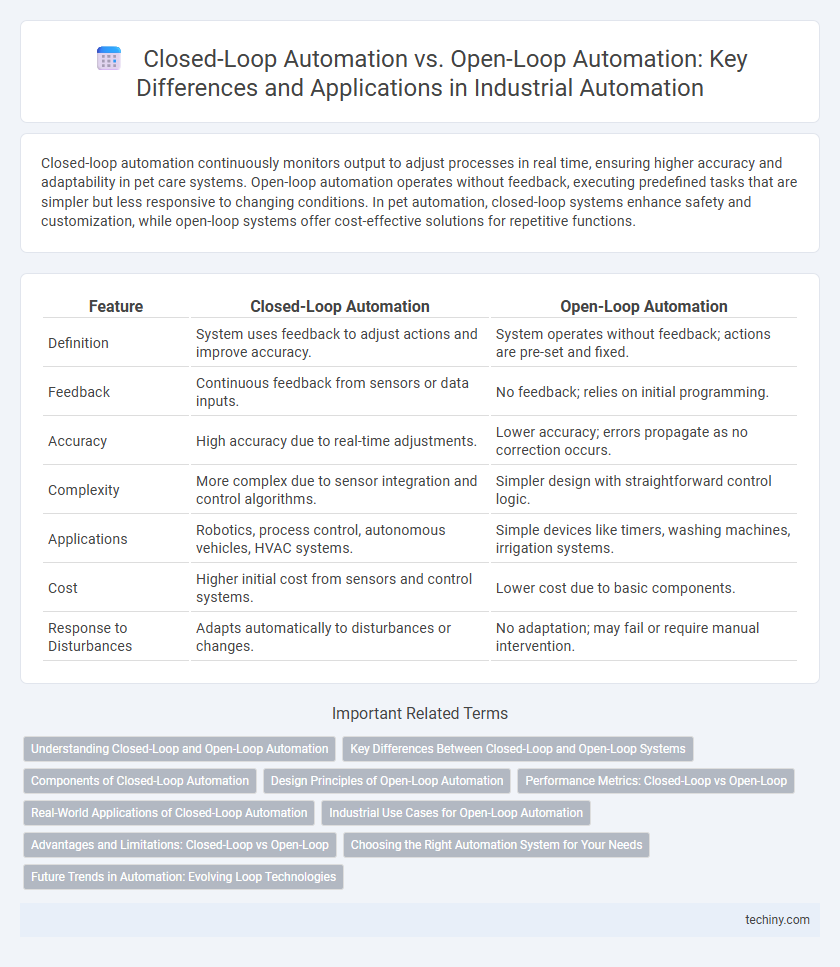Closed-loop automation continuously monitors output to adjust processes in real time, ensuring higher accuracy and adaptability in pet care systems. Open-loop automation operates without feedback, executing predefined tasks that are simpler but less responsive to changing conditions. In pet automation, closed-loop systems enhance safety and customization, while open-loop systems offer cost-effective solutions for repetitive functions.
Table of Comparison
| Feature | Closed-Loop Automation | Open-Loop Automation |
|---|---|---|
| Definition | System uses feedback to adjust actions and improve accuracy. | System operates without feedback; actions are pre-set and fixed. |
| Feedback | Continuous feedback from sensors or data inputs. | No feedback; relies on initial programming. |
| Accuracy | High accuracy due to real-time adjustments. | Lower accuracy; errors propagate as no correction occurs. |
| Complexity | More complex due to sensor integration and control algorithms. | Simpler design with straightforward control logic. |
| Applications | Robotics, process control, autonomous vehicles, HVAC systems. | Simple devices like timers, washing machines, irrigation systems. |
| Cost | Higher initial cost from sensors and control systems. | Lower cost due to basic components. |
| Response to Disturbances | Adapts automatically to disturbances or changes. | No adaptation; may fail or require manual intervention. |
Understanding Closed-Loop and Open-Loop Automation
Closed-loop automation continuously monitors system outputs and adjusts inputs to maintain desired performance, optimizing accuracy and efficiency in dynamic environments. In contrast, open-loop automation operates on predefined instructions without feedback, making it suitable for repetitive tasks where conditions remain constant. Understanding the distinctions between these systems is essential for selecting the right automation strategy based on process variability and control requirements.
Key Differences Between Closed-Loop and Open-Loop Systems
Closed-loop automation systems utilize feedback loops to continuously monitor and adjust processes, enhancing accuracy and adaptability, whereas open-loop systems operate without real-time feedback, relying solely on predefined inputs. Closed-loop systems optimize performance by correcting deviations, leading to improved precision and reduced errors. Open-loop automation offers simplicity and lower initial costs but lacks the dynamic responsiveness found in closed-loop configurations.
Components of Closed-Loop Automation
Closed-loop automation incorporates sensors, controllers, and feedback mechanisms to continuously monitor and adjust system performance for optimal outcomes. Key components include real-time data acquisition devices, programmable logic controllers (PLCs), and actuators that respond dynamically to sensor inputs. This integration of feedback control distinguishes closed-loop systems from open-loop automation, enabling precise process regulation and error correction.
Design Principles of Open-Loop Automation
Open-Loop Automation operates without feedback, relying on predetermined instructions and schedules to perform tasks, making it simpler and easier to design but less adaptive to changes. Its design principles emphasize straightforward control logic, fixed input parameters, and minimal sensor integration to reduce complexity and cost. This approach suits environments with predictable processes where real-time monitoring and adjustments are not critical for performance.
Performance Metrics: Closed-Loop vs Open-Loop
Closed-loop automation significantly outperforms open-loop systems in terms of accuracy and adaptability by continuously monitoring output and making real-time adjustments based on feedback. Performance metrics such as response time, error rate, and system stability consistently show enhanced efficiency and reduced deviations in closed-loop automation compared to open-loop systems that operate without feedback control. These improvements lead to higher process reliability and optimized operational throughput in automated environments.
Real-World Applications of Closed-Loop Automation
Closed-loop automation enhances industrial processes by continuously monitoring output and adjusting operations in real time, increasing efficiency and reducing errors. In manufacturing, robotics systems use closed-loop feedback to maintain precision in assembly lines, while HVAC systems optimize energy use by adjusting based on temperature sensors. Autonomous vehicles implement closed-loop automation to process sensor data for navigation and safety, demonstrating its critical role in dynamic, safety-sensitive environments.
Industrial Use Cases for Open-Loop Automation
Open-loop automation is widely applied in industrial settings where processes follow predefined sequences without feedback adjustment, such as in conveyor belt systems and simple assembly line operations. It enables consistent task execution in environments with stable conditions, reducing the complexity and cost of automation systems. Industries like packaging, textiles, and basic material handling benefit from open-loop control due to its straightforward integration and reliable performance under fixed parameters.
Advantages and Limitations: Closed-Loop vs Open-Loop
Closed-loop automation offers real-time feedback control, enhancing system accuracy and reducing errors by continuously monitoring outputs and adjusting inputs accordingly, which improves reliability in applications like manufacturing and robotics. Open-loop automation, while simpler and often less expensive, lacks feedback mechanisms, leading to potential inaccuracies and inability to correct errors or adapt to variable conditions. The main limitation of closed-loop systems is higher complexity and cost, whereas open-loop systems face constraints in precision and adaptability, making the choice dependent on the specific requirements for control and responsiveness.
Choosing the Right Automation System for Your Needs
Closed-loop automation systems provide real-time feedback and adjustments, enhancing precision and reliability, making them ideal for complex processes requiring high accuracy. Open-loop automation, lacking feedback mechanisms, suits simpler, repetitive tasks where process conditions remain constant and monitoring is less critical. Selecting the right automation system depends on factors such as process complexity, desired control accuracy, and the need for adaptive responses to environmental changes.
Future Trends in Automation: Evolving Loop Technologies
Future trends in automation emphasize the integration of advanced closed-loop systems, leveraging real-time sensor feedback and AI-driven analytics to enhance precision and adaptability. Open-loop automation remains relevant for simple, repetitive tasks but is increasingly augmented by hybrid models incorporating selective feedback mechanisms. Innovations in machine learning and IoT connectivity are driving the evolution of loop technologies toward more autonomous, self-correcting industrial processes.
Closed-Loop Automation vs Open-Loop Automation Infographic

 techiny.com
techiny.com